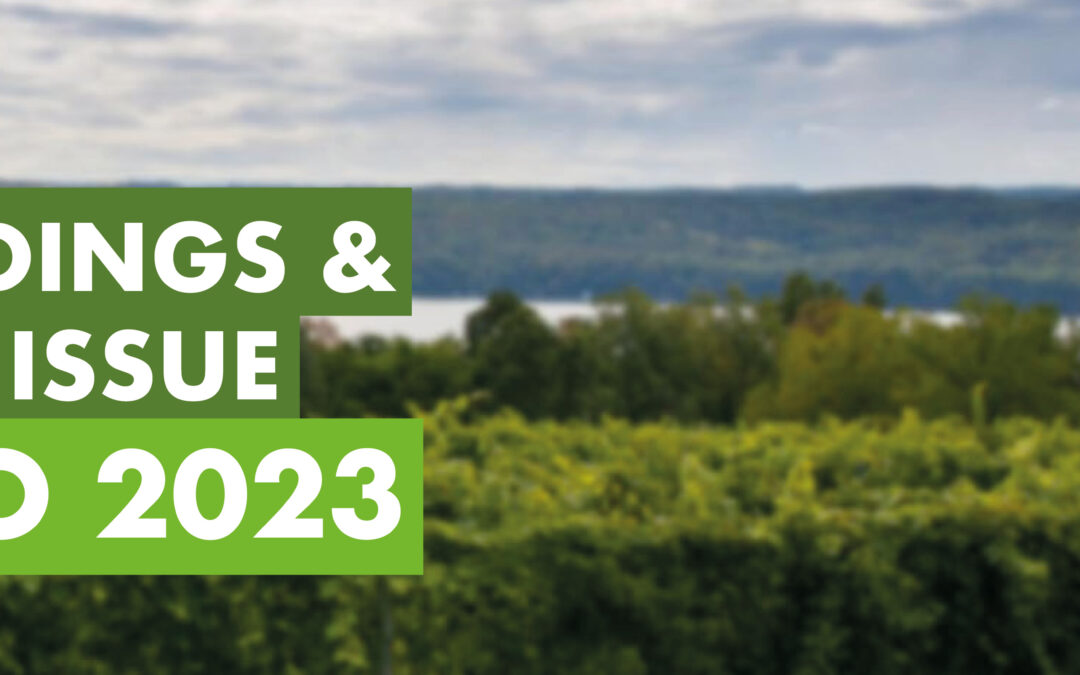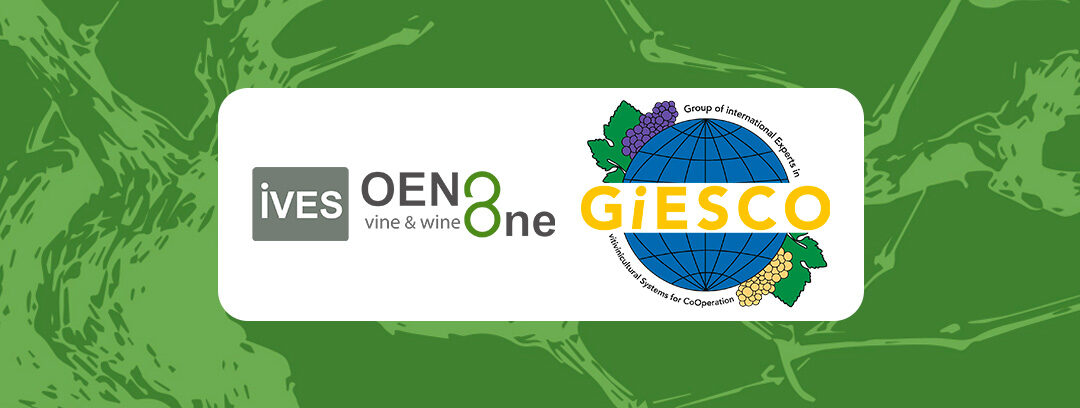Full understanding of grapevine responses to variable soil resources requires
assessing the grapevine root system. Grapevine root systems are expansive and examining deep roots (i.e., >40 cm)
is particularly important in conditions where grapevines increase reliance on deep soil resources, such as drought
or plant competition. Traditional methods of assessing roots rely on morphological traits associated specific
functions (e.g., root color, diameter, length), while recent methodological advances allow for estimating root
function more directly (e.g., omics). Yet, the potential of applying refined methods remains underexplored for roots
at deep depths.
GIESCO 2023

GiESCO 2023 | Proceedings & special issue
Discover the proceedings and the special issue of the 22nd GiESCO International Meeting 2023, with Open Access on IVES Conference Series and OENO One.
Swiss program for the creation of fungal disease resistant grape varieties in Switzerland
Grapevine breeding is part of the research program of Agroscope in Switzerland since 1965. From 1965 to 1995, the aim of the Vitis vinifera crosses was to obtain a high resistance to grey rot (Botrytis cinerea), one of the most virulent fungal pathogens in the Swiss vineyard. In 2021, the grape varieties released from this first breeding program covered 936 ha of the 15’000 ha of the Swiss vineyard.
In 1996, a second breeding program aimed at obtaining, by classical interspecific hybridization, grape varieties resistant to downy mildew (Plasmopara viticola) and powdery mildew (Erisyphe necator) and less sensitive to grey rot (Botrytis cinerea). In order to accelerate and make the selection process more reliable, an early biochemical test was developed based on the natural defense mechanisms of the vine against downy mildew (stilbene phytoalexins). The synthesis of stilbenes (i.e., resveratrol and its oxidized dimers - and -viniférine) and pterostilbenes (methylated derivative) is among the most efficient induced defense mechanisms of grapevine against fungal pathogens on both the leaves and the clusters.
Heatwaves impacts on grapevine physiology, berry chemistry & wine quality
Climate change impacts on both yields and quality have increased over the past decades, with the effects of extreme climate events having the most dramatic and obvious impacts. Increasing length and intensity of heatwaves associated with increased water stress necessitates a reevaluation of climate change responses of grapevine and, ultimately, a reconsideration of vineyard management practices under future conditions. Here we summarize results from a three-year field trial manipulating irrigation prior to and during heatwave events to assess impacts of water application rates on vine health and physiology, berry chemistry, and wine quality. We also highlight potential mitigation strategies for extreme heat, both in terms of water application, as well as other cultural practices that could be widely applicable.

Special issue: OENO One – GiESCO 2023
Read freely the 10 articles published in our open access peer reviewed research journal OENO One for the GiESCO 2023 (Ithaca, USA).
Could intermittent shading, as produced in agrivoltaics, mitigate global warming effects on grapevine?
Global warning increases evaporative demand and accelerates grapevine phenology. As a consequence, the ripening phase shifts to warmer and drier periods. This results in lower acidity and higher sugar levels in berries, yielding too alcoholic wines with altered organoleptic properties. Agrivoltaics, which combines crop and renewable energy production on the same land using photovoltaic panels, emerged as a promising innovation to counteract these impacts by partially shading the plants.
Selected ion flow tube mass spectrometry: a promising technology for the high throughput phenotyping of grape berry volatilome
Wine grapes breeding has been concentrating a lot of efforts within the grape research community over the last decade. The quick phenotyping of genotype quality traits including aroma composition remains challenging. Selected Ion Flow Tube Mass Spectrometry (SIFT-MS), a technology first available in 2008 and developing rapidly, could be particularly valuable for this usage. The aims of this study were i) to use SIFT-MS, to analyze the whole volatilome from different grape varieties, ii) to assess the ability of this technology to discriminate varieties according to their grape aroma composition, and iii) to study the stability of SIFT-MS signal over maturation to define a sampling strategy.
VITIGEOSS Business Service: Task scheduling optimization in vineyards
Agriculture plantations are complex systems whose performance critically depends on the execution of several types of tasks with precise timing and efficiency to respond to different external factors. This is particularly true for orchards like vineyards, which need to be strictly monitored and regulated, as they are sensitive to diverse types of pests, and climate conditions. In these environments, managing and optimally scheduling the available work force and resources is not trivial and is usually done by teams of senior managers based on their experience. In this regard, having a baseline schedule could help them in the decision process and improve their results, in terms of time and resources spent.
Increasing microalgae biomass feedstock by valorizing wine gaseous and liquid residues
Global warming due to greenhouse gases (GHG) has become a serious worldwide concern. The new EU Green Deal aims t0 achieve GHG emissions reduction by at least 55% by 2030 and a climate neutral EU economy by 2050. The deal strongly encourages GHG reducing measures at local, national and European levels. The REDWine project will demonstrate the technical, economic and environmental feasibility of reducing by, at least, 31% of the CO2 eq. emissions produced in the winery industry value chain by utilizing biogenic fermentation CO2 for microalgae biomass production
Comparison of the skin resistance of several grape varieties in relation to their physico-chemical properties
The purpose of this study is to compare the skin resistance (SR) of the grapes with physico-chemical propertiess using a stong dataset and multidimentional statistical analysis .
A recent study has shown the role skin resistance plays against pest invasion but skin resistance could be a useful agronomic parameter, for example in the choice of the type of winemaking, by influencing the quantity of juice during crushing and maceration.
Investigating the conceptualization and practices linked to peppery notes in Syrah red wines by French winemakers from different regions
The peppery attribute is often used to describe the aroma of Syrah wines. Rotundone was identified as the main aroma compound responsible for these notes. A significant percentage of anosmic respondents to this molecule was reported in previous studies. However, in most cases, these anosmic respondents, formally tested through three-alternative forced choice (3AFC), frequently declare being able to perceive peppery notes in wines. The main objective of this study was to investigate how anosmic French producers from two different regions conceptualize the peppery notes in Syrah red wines, and how they link it to production practices in comparison with non-anosmic producers.
Distribution of photosynthates towards the grapes: effects of leaf removal and cluster thinning applied before veraison in cv. Verdejo
The relationship between grape production and leaf surface is a highly debated aspect in terms of the impact it may have on the composition and quality of grapes, especially in areas that focus their cultivation on high-quality wine. In many occasions, the limitation of the unitary production level in these areas is claimed to be the main factor for achieving high quality levels in the wine, forgetting the importance of the source-sink relationship and other environmental factors and management of the canopy. Taking this consideration into account, this work seeks to know the response of the vine as a whole, and the individual shoot as well, to the application of various alternatives of leaves and clusters removal, carried out in the phase immediately before veraison, in cv. Verdejo, in Spain.
Creativini: an augmented reality card game to promote the learning of the reasoning process of a technical management route for making wine
Nowadays, the entire viticultural and enological process is wisely thought out according to the style of wine to be produced and the local climatic conditions. Acquiring the approach of a technical management route specific for wine production remains a complex learning process for students. To enhance such learning, The Ecole d’Ingénieurs de PURPAN (PURPAN), an engineering school located in Toulouse southwest France, has recently developed Creativini, a collaborative card game in English made of 150 cards spread into 14 batches. Students in groups of 3 to 6 must design a technical production route, from plant material to bottling.
The challenge of improving oenological quality in favorable conditions for productivity
Marselan (Cabernet-Sauvignon x Grenache), has been planted for more than 20 years now in Uruguay. Due to its good agronomic and oenological aptitudes under uruguayan conditions, it is currently the red variety with highest plantation rate. The objective of the study was to identify management practices, aimed at improving quality in highly productive vineyards, different fruit/leaf regulation methods were tested in southern Uruguay.
Techniques to study graft union formation in grapevine
Grapevines are grown grafting in most viticultural regions. Grapevine rootstocks are either hybrids or pure species of different American Vitis spp. (particularly V. berlandieri, V. rupestris and V. riparia), which are primarily used to provide root resistance to the insect pest Phylloxera. In addition to Phylloxera resistance, ideally grapevine rootstocks should be resistant to other soil borne pathogens and adapted to abiotic stress conditions. New rootstocks have the potential to adapt agriculture to climate change without changing the characteristics of the harvested product. However, high grafting success rates are an essential prerequisite.
Diagnosis of soil quality and evaluation of the impact of viticultural practices on soil biodiversity in a Southwestern France vineyard
The soil plays a pivotal role in the agroecological transition processes, due to its numerous implications in production support, water regulation, air and nutrient supply, and its function of reservoir for the major part of planet biodiversity. Therefore, soil quality and adequate soil management are key levers for an ecologically and economically sustainable viticulture. Gascogn’Innov (2017-2022) is an Operational Group funded by the European Innovation Partnership for Agriculture. As such, it gathered winegrowers from the south-west of France (Gascony), scientists, advisors and technicians, around a project focused on the biological functioning of viticultural soil and the design of better-adapted technical paths for soil protection.
Diversity of arbuscular mycorrhizal fungi on grapevine roots across an edaphoclimatic gradient
Challenges associated with climate change, such as soil erosion and drought, have impacted viticulture across wine regions globally in recent decades. As winegrowers struggle to maintain yield and quality standards under these conditions, methods to adapt to and mitigate the impacts of climate change have become more prevalent. One potential mitigation strategy is to enhance symbiotic interaction of grapevine roots with arbuscular mycorrhizal fungi (AMF).
Towards stopping pesticides: survey identification of on-farm solutions
The winegrowing sector consumes a lot of pesticides. Changes in vineyard are necessary in order to reduce or even stop using pesticides, and thus limit their harmful impacts on health and on environment. To answer these issues, the VITAE project (2021-2026) aims at designing pesticide free grapevine systems in France. For that, we take an interest in the vineyards using solutions to strongly reduce chemicals but also biopesticides. We assume that such vineyards exist and that they are implementing solutions that could inspire the design of free- pesticide system.
